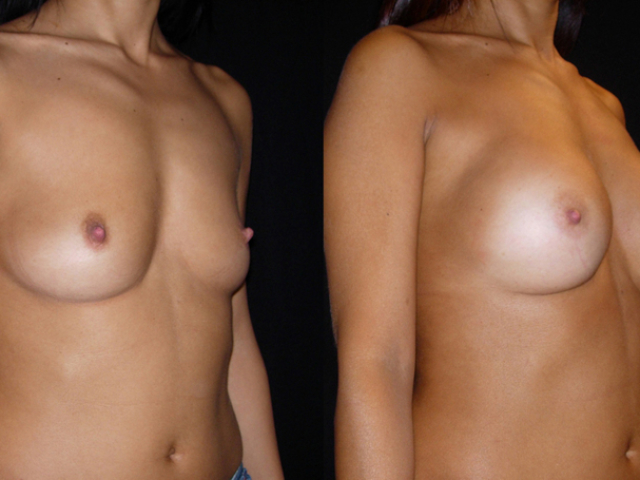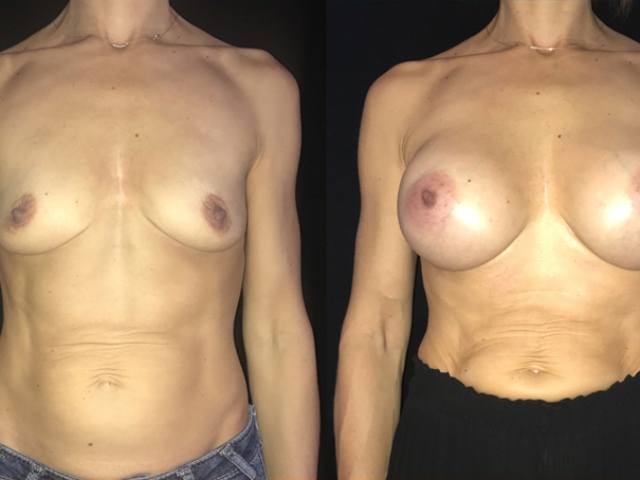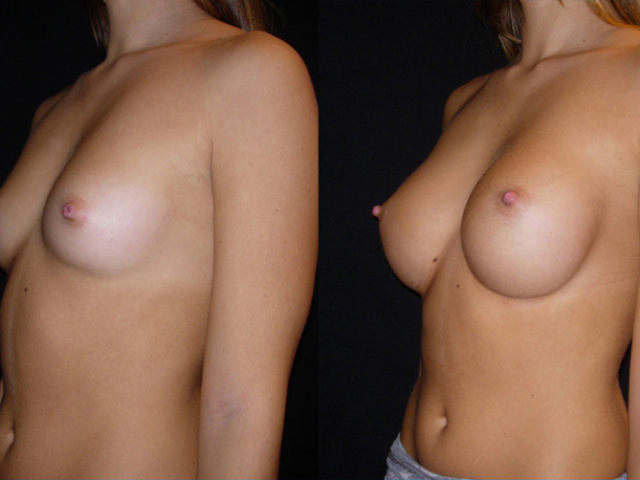Breast Enlargement
Breast Enlargement
Prodcedure:
50-60 minutesAnaesthesia:
General or local with sedationBack To Work:
1 nightHospitalisation:
2-4 weeks depending on job typeCost:
5,000-8,000 eurosBreast Augmentation (or Augmentation Mammaplasty) and Breast Augmentation with Fat Grafting (Lipofilling)
Introduction
There are two basic techniques to increase breast size and enhance breast shape: Augmentation mammaplasty (the most common method), and breast augmentation with fat grafting (lipofilling) to transfer fat from one area of the body to the breasts. Patients who desire a moderate increase in breast size may be ideal candidates for this technique.
Below we answer the questions that are posed to us most frequently during consultations for breast augmentation with implants and breast augmentation with fat grafting.
Which techniques can enhance breast size?
The surgical options for breast enlargement fit largely into three categories:
1) breast implants
2) fat grafting – using fat cells harvested from other areas of the body
3) Macrolane hyaluronic acid filler (this technique is currently under review over concerns with breast cancer screening difficulties).)
Who is an ideal candidate for Breast Enlargement?
Breast enlargement is carried out for a variety of reasons:
- to increase breast size in underdeveloped breasts
- to improve the appearance of malformations such as tuberous breasts/li>
- to achieve more balanced proportions/li>
- to enhance breast symmetry./li>
Careful evaluation of patients with a considerable amount of sagging and loss of breast volume (a common issue after childbirth or breastfeeding) is essential to define an appropriate treatment plan. These patients usually require a breast lift (mastopexy surgery) to shape and lift the breasts combined with an augmentation mammaplasty in order to achieve optimal results. Women who seek breast enlargement are often motivated by the profound effect the flawed appearance of their breasts has on self-perception and esteem, and the desire to enhance body-image and feel more secure about expressing their femininity.
What types of breast implants are available?
The development of surgical techniques and medical devices has led to significant advances in breast enhancement surgery to offer patients safer, natural-looking results with less downtime. This is largely thanks to the latest innovations in breast implant technology.
Breast implants can be round, anatomical or teardrop in shape, with low, moderate, high or extra high projection. The final choice depends on the original, natural breast, and the patient’s aesthetic goals. Ergonomic breast implants harness the latest technology with cohesive silicone implants that can adapt to natural movement.
Breasts appear either round or teardrop-shaped depending on posture. Ergonomic implants are now the most popular choice for breast enhancement. All breast implants are filled with silicone gel (not fluid) to offer the most natural look and feel possible.

Are all implants the same quality?
Based on international certification and our own experience, the safety standards and quality of breast implants can vary significantly. There are more expensive options (due to the higher manufacturing costs) with outstanding quality and safety standards, on the market alongside cheaper, inferior quality implants developed to cut costs. Patients should avoid less expensive varieties as these equate to inferior quality implants, and compromised safety standards. The best way to evaluate implant quality is to check what type of certified approval it holds.
Which are the main types of regulatory approval for breast implants?
There are two main types of regulatory approval to ensure the quality and safety of medical devices: the CE Mark in the European Union and FDA- approval (Food and Drug Administration) in the United States. Some breast implants hold the CE Mark, but they are not FDA approved. We use only the finest quality implants, approved by both authorities to ensure the highest standard of quality and safety for our patients. Undoubtedly, the CE Mark is a satisfactory quality guarantee for implants; however, in our opinion, two certified approvals provide greater assurance. Our advice to patients is to pay careful attention to the quality of implants and to resist the temptation of low-cost surgery.
What about the scars following Breast Augmentation?
Residual scarring depends on the location of the incision lines. This issue should be discussed in detail beforehand. The scars are well hidden in discreet areas, and there are several options for incision placement:
1) Periareolar incision – a semi-circular incision around the lower half of the areola or nipple. This technique can be applied depending on various factors, including areola size and symmetry.
2) Inframammary incision – an incision under (or slightly above) the breast crease. Scars can be concealed under swimwear or underwear, even with the arms in a raised position.
3) Transaxillary (armpit) incision this is the least common choice for patients and surgeons. The incision is placed vertically alongside the edge of the pectoral muscle or horizontally to the armpit. Patients who request this type of incision, do so as they believe that the scars are less visible. This general misconception is not only inaccurate, but it fails to consider that residual scarring is more noticeable when the arms are raised. The internet is full of shots of female celebrities photographed with visible residual scarring when lifting their arms to wave to fans.

As breast augmentation requires a good deal of planning and decision-making, establishing the pros and cons of each technique is a fundamental part of deciding on the most suitable treatment.
What are the options for breast implant placement?
After the surgeon has established the incision technique and explained residual scarring, it is time to decide on breast implant placement. There are various options available:
- subglandular – directly behind the breast
- subfascial – between the thin layer of connective tissue (fascia) and the chest wall
- submuscular – behind the breast and chest wall
- dual-plane – partly behind the breast and partly behind the muscle
A range of technical factors determines the final choice for implant placement, including the amount of natural breast tissue the patient has to support the breast implants. Women with a naturally good breast shape may be ideal candidates for subglandular or subfascial placement. Whereas submuscular or dual-plane placement is suitable for slender patients with a limited amount of breast tissue.
What is subfascial placement?
In our practice, subfascial placement (between the layer of fascia and the chest wall) is now the most popular choice for breast augmentation. This position provides the same benefits as subglandular placement and other advantages as we can see below.
Subfascial placement, developed by Dr Ruth Graf, positions the breast implant over the pectoral muscle, (as with subglandular placement) but the implant is placed under supporting tissue. According to research and our practice, subfascial placement achieves a more natural-looking breast shape. It allows the surgeon to drape and tighten the layer of fascia, improving coverage and concealing the outline. Furthermore, this technique reduces the risk of complications, including implant movement, rippling above the areola and (according to various clinical studies) capsular contraction.
What type of anaesthesia is used in Breast Augmentation?
Breast enlargement is routinely performed under general anaesthesia to reduce discomfort to a minimum. Local anaesthesia with intravenous sedation (administered by a qualified anesthesiologist) may be used for patients who want a more moderate increase in breast size.
Breast FAQ
Please contact us for more information about Breast Augmentation Surgery. Contact Us
What does Lipofilling (or fat grafting) involve?
Breast augmentation with the fat grafting technique is used to enhance breast volume by re-injecting fat cells to increase breast volume and shape. It is, perhaps, one of the most revolutionary methods to have been developed in recent years.
Fat grafting is a standard procedure in plastic surgery as it is ideal for enhancing and balancing specific areas of the breasts. This technique is currently under review due to a suspected link between its use and an increased risk of breast cancer.
However, fat grafting was approved in 2009 by the American Society of Plastic Surgeons, and in 2011, the French Society for Cosmetic and Reconstructive Surgeons approved its use and issued guidelines for technique application. Fat grafting can be used in plastic reconstructive surgery for post-mastectomy patients and cosmetic breast enhancement.
Fat transfer breast augmentation uses liposuction to remove fat from another part of the body. After removal, the fat is processed and re-injected into the breasts.
Who is an ideal candidate for Lipofilling?
Technical considerations, such a sufficient supply of fat and personal preferences concerning the patient’s natural breast size usually determine the decision to apply this technique. It is an ideal choice for women who desire a relatively small increase in breast size compared to the more noticeable (and immediate results) obtained with breast implants. The patient should clearly understand beforehand that a limited amount of fat can be transferred during surgery. Therefore, it may be necessary to perform more than one operating session to achieve the desired result. Furthermore, fat cannot offer the same firm support like breast implants; therefore, lipofilling cannot achieve the same results.
Contact us for more information on Breast Augmentation with the fat transfer technique. Contact Us
Aumento del volume del seno con acido ialuronico Macrolane®
Breast Augmentation with hyaluronic acid filler (Macrolane)
Macrolane is not approved for breast enlargement in Italy due to issues regarding breast cancer screening. We advise that patients never use other types of hyaluronic filler for breast augmentation.









